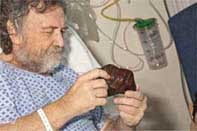Can museums make you healthy?
By Linda Thomson, on 10 March 2011
For the last three years, an innovative programme of research called ‘Heritage in Hospitals’ has been carried out by UCL Museums & Collections, where museum objects are taken into hospitals and other healthcare settings. Patients are invited to handle and discuss the objects at their bedsides with a researcher, in sessions that typically last around 30 to 40 minutes. Researchers from UCL turn up at the hospital with their boxes of museum objects during afternoon visiting hours and patients are encouraged to select an object and give reasons for why they are attracted to it. Sometimes a participant will select an object on purely visual grounds saying “That one looks interesting” or “I like the colour of this one”. At other times a participant will run their hand over the surface of all of the objects and comment “I like the feel of this one” or “I’ll choose this one because it feels cool”.
Objects include archaeological artefacts e.g. Egyptian amulets, pots and pottery shards, flint hand axes and knives; artworks e.g. copper etching plates and prints from 1950’s Slade School of Art students; geological specimens e.g. agate and malachite minerals, ammonite and micraster fossils; and natural history items e.g. seashells, eggs, horns and teeth.
Participant handling a turtle carapace
Over 250 object handling sessions have been carried out with participants across a range of healthcare environments including acute and elderly care, gynaecological oncology, general oncology, and surgical admissions wards in University College Hospital; rehabilitation wards from the National Hospital for Neurology and Neurosurgery, and the Oxford Enablement Unit; Prospect Park Psychiatric Hospital, Reading; and residential care homes in North London.
An important aspect of the research is understanding patient responses to handling and discussing museum objects and the impact of these activities on their general psychological wellbeing. Before and after the handling sessions, patients complete two psychological wellbeing measures that assess states of general wellbeing and happiness. Patients are also asked to rate ten positive emotion words (e.g. enthusiastic, interested, inspired) and ten negative emotion words (e.g. nervous, scared, hostile) that are randomly presented, on a scale of one-to-five.
Findings from the ‘Heritage in Hospitals’ research have revealed improvements in measures of wellbeing and happiness when scores from before and after the sessions are compared. Specifically, these include increases in ratings given to positive emotion words and decreases in ratings given to negative emotion words. Analysis of the conversations showed that participants were stimulated by the tactile and social interaction and distracted from their clinical surroundings. One patient commented “It’s a way of stimulating thoughts but an easier way (than reading) because you’re talking”. Many participants reported feeling bored prior to the sessions but experienced enjoyment and inspiration through the object handling: “It has cheered me up no end, it’s something from the outside, it’s good”. Some remarked that they had learnt something new, something to tell their grandchildren or visitors whereas others said it had awakened a past interest they might pursue again: “They’re dead objects from thousands of years ago but it does connect you with life”. Interviews with staff indicated that participants became more alert after the sessions and were more talkative and sociable.
The ‘Heritage in Hospitals’ project was funded by the Arts and Humanities Research Council (AHRC) to assessed the potential of engaging with heritage objects as a therapeutic and enrichment activity in hospital. The research has provided a ‘How to’ protocol for future research and methodology for evaluating the impact of object handing in healthcare, and a best practice guide for museum and hospital staff is in the process of preparation.
For more information about the ‘Heritage in Hospitals’ project go to:
http://www.ucl.ac.uk/museums/research/touch/wellbeing
Or email:
Dr Helen Chatterjee, Project Leader: h.chatterjee@ucl.ac.uk
Dr Linda Thomson, Lead Researcher: linda.thomson@ucl.ac.uk
You might also be interested in the following articles:
Chatterjee, H.J., Vreeland, S. & Noble, G. (2009) Museopathy: Exploring the Healing Potential of Handling Museum Objects. Museum and Society. 7(3), 164–177.
Noble, G. & Chatterjee, H.J. (2008), Enrichment programs in hospitals: Using museum loan boxes in University College London Hospital. In H.J. Chatterjee (Ed.) Touch in Museums: Policy and Practice in Object Handling. pp. 215–223, Oxford: Berg.
H.J. Chatterjee (2008) Touch in Museums: Policy and Practice in Object Handling. Oxford: Berg.
Ander, E.A., Thomson, L.J., Noble, G., Lanceley, A., Menon, U. & Chatterjee, H.J. (In Press) Generic Wellbeing Outcomes: Towards a conceptual framework for wellbeing outcomes in museums. Museum Management and Curatorship.
Lanceley, A., Noble, G., Johnson, M., Balogun, N., Chatterjee, H.J. & Menon, U. (In Press) Investigating the therapeutic potential of a heritage-object focused intervention: A qualitative study. Journal of Health Psychology.
Thomson, L.J., Ander, E.A., Lanceley, A., Menon, U. & Chatterjee, H.J. (In Press) Evaluating the therapeutic effects of museum object handling with hospital patients: A review and initial trial of wellbeing measures. Journal of Applied Arts and Health.
 Close
Close

